The journey of creating your own blog is often an exciting and interesting one, but it’s fraught with challenges. I’ve created this how to start a blog guide so that even beginners can begin writing their blogs without encumbrances like learning HTML or long tutorial videos. One more reason why I wanted to write down this? to save lots of you from the immense financial mistakes that tons of individuals encounter within the method.
Contents
- 1 How to Start A Blog with a few clicks?
- 2 How to Start a blog? Detailed guide!
- 3 Step 1: Choosing the Best Platform
- 4 Step 2: Register a Domain Name and Web Hosting Service
- 4.1 – Domain Names
- 4.2 – Web Hosting Services
- 4.3 Sources of Domain Names and Hosting Sites-
- 4.4 Two important factors to consider before looking into blog building:
- 4.5 – Initiate Blog Setup on Self-Hosted WordPress
- 4.6 – Buckle in a Hosting Plan
- 4.7 – A Short Intro on Domain Name Selection
- 4.8 – Pick Something that grabs a user’s attention
- 4.9 – Boring and Non-descript is so Out
- 4.10 – Add a Good Extension
- 4.11 – What Next?
- 4.12 – Complete Registration Process
- 4.13 – Get ready to Sign In and Install WordPress Blog!
- 4.14 – Login for the New Blog
- 5 Step 3: Prepare to Launch the Tweaking, Designing and Configuration Part!
- 6 Step 4: How to Write Blog Posts and Pages
- 7 Step 5: The Ultimate Step: Making a Successful Blog
- 8 Still, have Problems while Setting Up Your Blog?
FYI, this is often going to be a ≈4400 word long blog so you’ll need about 20 minutes to read this through. Take some time, bring over a cup of relaxing tea, stimulating coffee, or delicious cocoa, and start on this exciting journey.
Once you’re through with the initial setup for your blog, you’d possibly want to ascertain out my additional instructional guides to attract a greater number of tourists and also to make money from your blog for an effortlessly easy beginning.
How to Start A Blog with a few clicks?
Step 1. Choosing the best Platform.
In the first step, we will assist you to select the best platform with your preference. We suggest you to you to travel with the WordPress platform as techlogitic.net is on WordPress and you will see the handsome look of the blog and structure also.
Step 2. Registering a site Name and Web Hosting.
In the second step, we will have a look at the free blog names using which you would possibly be representing your business. you’ll take TLDs like “org”, “net” or “com” again as per your preference. Moving forward an internet site name isn’t enough we’ll need a hosting provider to store our website files. we’ve added some inquiries to see out before deciding which one to need. As per our experts and WordPress, we give it a go when using Bluehost Hosting. found out your free WordPress directly and blog for free of charge.!
You can even avail of a free domain coupon. If you purchase an annual WordPress hosting there’s an opportunity of Bluehost to supply you with a free domain.
Step 3. Prepare to Launch the Tweaking, Designing, and Configuration Part!
Once the domain is mapped to your hosting provider. It leaves us with the planning of the blog. Let’s take a look at techlogitic.net I bought an honest tech news magazine from Themeforest – one of the foremost important theme/plugin marketplace out there. during this step, I even have added some steps on the thanks to configuring the theme settings and what necessary plugins are to be activated for the betterment of your new blog.
Step 4. the way to Write Blog Posts and Pages.
Once through with all it leaves us with adding content as per our blog’s behavior. Techlogitic could also be a tech blog so accordingly, I even have added posts related to tech/software/reviews/hosting/blogging/SEO and much of more. a fast word on adding a replacement post is to feature visualizations (graphic images make superb content) within the post and follow the structure like adding proper H2/H3/H4 tags for google crawler to spot. I even have added some major points to look for once you acknowledged a blog post.
Step 5. The last step: Creating a Successful Blog.
This step helps you to feature a final touch to your blog like adding a contact us page which may let your readers reach you. Adding to the present, I even have added some references you would possibly want to require a glance while adding new content and being up-to-date with google policies like adding a privacy policy and lots of more.
And just in case you’re almost sure of it yet, inspect a guide for the eleven reasons you need to have your own blog. So, prepare because it’s close to getting the ball rolling now! be happy to contact me for any guidance!
How to Start a blog? Detailed guide!
Before are the steps explained in detail to help get the best out of us. The how to start a blog guide can help you with choosing the best hosting platform and how to create a blog with WordPress. It will help you clear your doubts on how to design your WordPress website in seconds.
Step 1: Choosing the Best Platform
If you’re worrying over the aesthetic look and feel of your blog, you’re probably getting far before yourself. the primary step is to choose a platform, and here you’ll be spoilt for choices with WordPress, Tumblr, Blogger being equally alluring.
Then again, there are 72 million users that use WordPress whose popularity spells out its awesomeness.
Reasons Why WordPress is a Compelling Choice:
- It’s the free platform that anybody can access at any point with tons of free features like themes, layouts and add-ons.
- The setup is an easy-breezy process so simple that children could set it up!
- WordPress also has tons of security features including constant software updates and security updates to protect from hackers. (So now you know why Sony, NASA and multiple universities use WordPress!)
- Customizability is awesome, with hundreds of free themes, plugins, etc. working to improve the experience and add greater functionality including contact and subscription options, etc.
Obviously, there are plenty of other platforms out there which deliver a decent performance, but nothing matches the customizability and independence which WordPress provides. In my opinion, this should be your go-to option especially if you’re just beginning! Hope this how to start a blog guide is helping you to achieve your steps one by one.
Take a look at Peter Keszegh blog – https://onlinebizbooster.net/affiliate-marketing-for-bloggers/
Listen up, though, because I’m about to let you in on a few secrets.
Why Shouldn’t You Use a Free Blogging Platform?
The reason is that a free website domain name doesn’t just impress anybody, especially if you want to someday be rich, famous and super-successful. “Imblogginglookatme.commonbloggingplatform.com” sounds so much less impressive than a “WatchMeBlog.com”, doesn’t it?
Note – If you are planning to start a blog from scratch it is recommended you spend a few bucks. Since with free platform comes greater sacrifices. Planning a proper how to start a blog guide is important for me and from the past experiences I did not manage to survive on free platforms for a longer time.
Some of the other problems with Free Blogging Platforms:
- Control of the content belongs not to you but the platform so obviously, they can close your blog any time they choose!
- The web address is hardly impressive: and even more than that it is NOT catchy enough to remember when followed by a “.blogspot.com”.
- Advertisements are not allowed on most free platforms which makes it more difficult to monetize the same.
Obviously, if you don’t particularly care about monetizing or making big waves as a celebrity blogger, a free platform is completely fine. But for people who want to build up a large follower base and monetize their blogs, a personalized domain and self-hosting features are absolutely essential. What’s more, this is just so much easier and very inexpensive as well.
Step 2: Register a Domain Name and Web Hosting Service
If I’ve convinced you to get your own self-hosted blog, then there are two things you need to look into:
– Domain Names
This is the web address which can let people find you by. For instance, the domain name for Google is, well, www.gooogle.com. Your blog will have a similar name, and you can choose whatever comes after the name: “.edu”, “.org”, “.com”… the choice is yours to make! The costs come around $10 a year but stay tuned for cheaper options.
– Web Hosting Services
Web hosting services are essential for accessing domains and work somewhat like a computer hard disk drive for storing content such as images, text, etc. Generally, web hosting comes around to $2-$5 every month. For the best results from your blog, it’s an absolutely essential investment.
Sources of Domain Names and Hosting Sites-
Sources for domain names registering-
- Godaddy
- Bluehost
- Hostgator
- Bigrock
- 1and1
- Namecheap
Sources of hosting providers –
- Bluehost
- Hostgator
- WpEngine
- Siteground
Two important factors to consider before looking into blog building:
- Page loading Speeds: This is generally the time taken by your blog to load up.
- Blog uptimes: 99.9% uptime provided by some hosting sites is not enough, because that still amounts to 42 minutes of downtime every month.
Many web hosting service providers offer similar packages with domain names and hosting and at very competitive price points, but I’ve had a fair bit of experience with many of them including Bluehost, iPage, GoDaddy, etc. One of the best services I found is Bluehost which provides a comprehensive solution for all my blogging needs.
This is because nothing beats the kind of loading speeds and uptimes, I get with Bluehost hosting company, and it provides an easy-to-use interface for beginners combined with brilliant performances. This is my personal pick, but of course, you are free to choose from one of many services so long as they offer reliable, speedy and unlimited storage plus bandwidth options for the best experience.
– Initiate Blog Setup on Self-Hosted WordPress
Now that you know about hosting services, choose one that can integrate itself with WordPress and get started on the process. Since Bluehost provides a one-click installation for WordPress, I’m not including a detailed guide but if you’re still determined, you can check out more complex installation guides for manual setup.
First, visit the website www.bluehost.com and select the “Get Started” icon. If you’re using any discounts, they should be applied at this stage.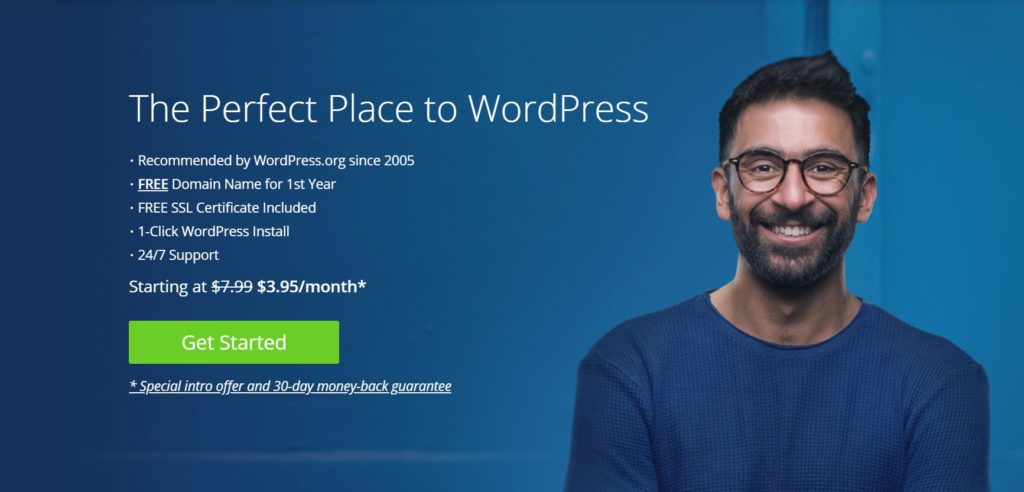
– Buckle in a Hosting Plan
There are multiple plans to choose from but most beginners can get by on the Hatchling plan, which is easily upgradeable to a more advanced plan in the future depending on needs.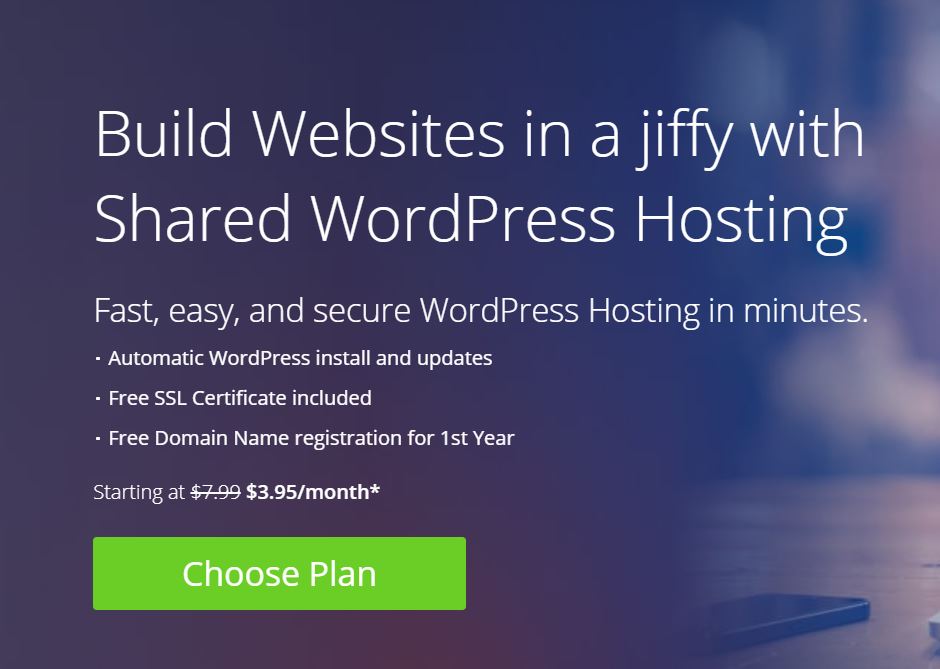
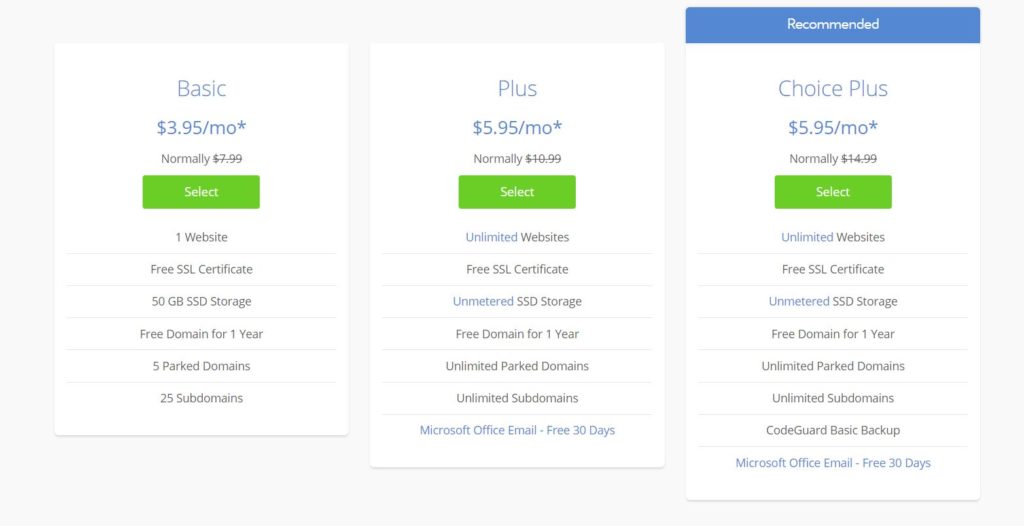
– A Short Intro on Domain Name Selection
And after choosing a hosting plan, a user will be redirected to domain page with options to create or Use a domain your own option.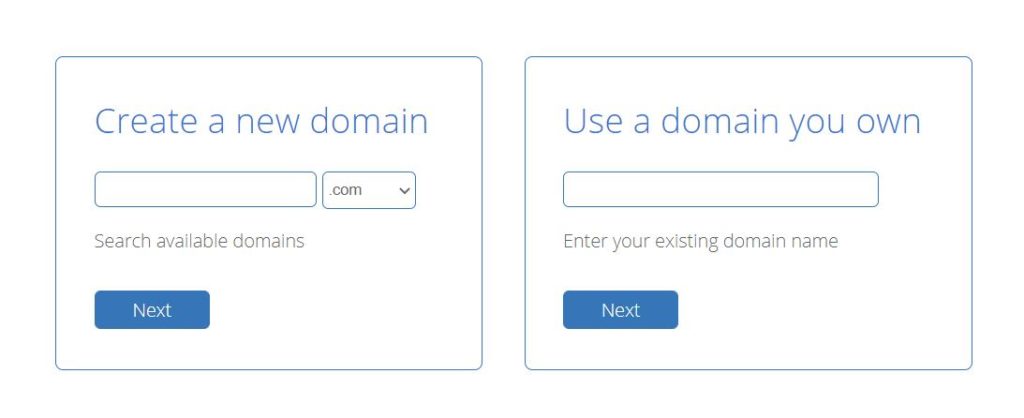
If you want to know how to choose a good domain name for your new blog: Check out the following guidelines, which can provide you with a detailed description of how to start your own blog with a fabulous domain name. Starting a blog is an easy step but the selection of a good domain name is a must. A good domain name represents you and yourself, think of it as if you share your blog to your friends on social media how they are going look at it.
– Pick Something that grabs a user’s attention
Think of a website that calls itself www.ha-89-fklse.com. Okay, so it looks cool and innovative at first…until you see that it makes zero sense, and is very hard to remember. So, not the best option okay? Too much complexity, long hyphens, and difficult spelling can be a bummer for many people! Strongly suggested for bloggers, don’t spam the internet just because you want an exact match domain.
– Boring and Non-descript is so Out
These days, domain names are a reflection of a person’s personality. Make your domain name unique and make it speak out for you. Get started with your new blog now!
– Add a Good Extension
Trust us, an extension can work wonders for you because who takes a “I’m-Serious.rocks” for anything valuable? So, choose something like “.com”, “.net”, “.edu” or “.org” depending on your needs. Choose a good blog name and extension.
– What Next?
After adding the domain, just sign-up for the payments page with the plan fee that has to be paid.
– Complete Registration Process
At this point, you’re all set to begin with your blog. Oh wait, first you need to insert details like contact address and billing information, customize the package a little bit, apply some discount coupons, etc.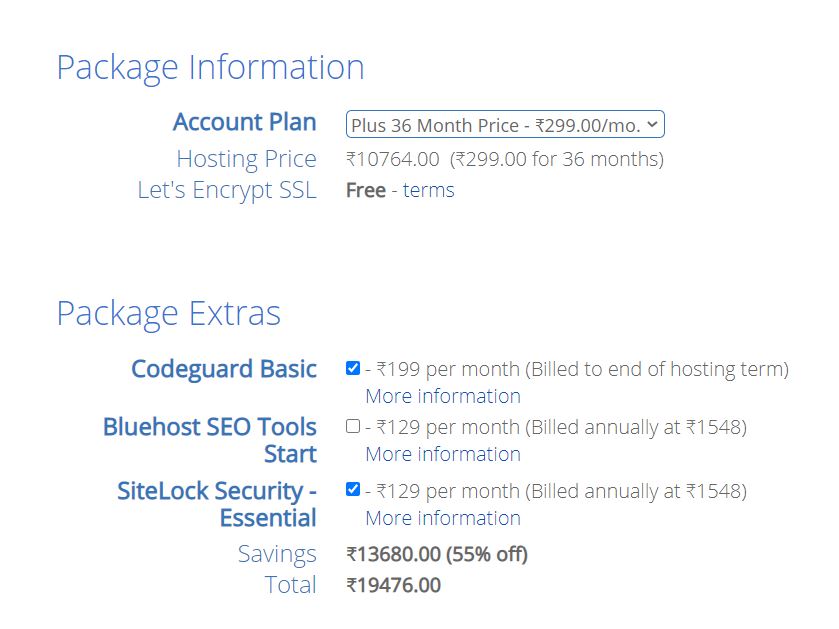
Some additional features you might want to choose are:
- Domain Privacy Protection: This discreetly hides sensitive information from a worldwide database with open access in case you wish to remain anonymous, but if saving a couple of bucks is more important, go right ahead!
- Unchecking Remaining Boxes: There will be additional features on the finalizing part that can be skipped because they are unnecessary for beginners.
– Get ready to Sign In and Install WordPress Blog!
Congratulations! You’ve successfully registered on Bluehost and have your first blog domain name. In a couple of minutes, a confirmation email will allow you to have access to your control panel and install WordPress with just a single mouse click.
Next, what you have to do is:
- Login to the Control Panel (Bluehost)
- Navigate to the Left Sidebar
- Install WordPress: select this option.
- Automatically get transferred to Mojomarketplace.com
- Stop panicking and see that the screen says Install or Import WordPress.
- Hit Install and you’re done.
A loading bar will now pop up to inform you that WordPress has been installed and you should soon see your login details.
– Login for the New Blog
The installation will auto-complete, after which you’ll get an email confirming your admin URL from which you can log in to your blog. Alternatively, just go to www.(yourdomainname).com/wp-admin. Congratulations because your WordPress blog is now ready to use! It wasn’t so hard after all, was it now? Update – For newer WordPress versions it is necessary to add an active email address. It sends you a confirmation email as well whenever you change the email address on the WordPress dashboard.
Step 3: Prepare to Launch the Tweaking, Designing and Configuration Part!
Congratulations, you’ve finally reached the section where I share with you some basic tips and tricks for WordPress including a familiarization guide for WordPress dashboards, changing the design elements, installing custom plugins and features, and making an SEO friendly blog. This is the really fun part, I promise!
Just remember, to log in to your blog all you need is to login through www.(yourdomainname).com/wp-admin/ and provide them the credentials setup through your hosting company of choice.
A Guide to the WordPress Dashboard
The first thing you see once you login to WordPress is the admin panel, also referred to as the dashboard, which looks a lot like this:
Here are the Important Elements which Beginners Should Learn About:
- The Dashboard provides a quick survey of recent activities including posts, comments and pages on your blog. It also allows users to draft quick blog posts right off the bat.
- The Posts button is where you should click for posting new blog posts or editing existing ones.
- Media button leads to a library of media files including pictures, videos and audio uploaded to the site.
- The pages option lets you add permanent pages including Contact Me pages or About Me pages and also allows you to manage existing ones.
- Comments option is where you can see your recent and old comments, comments awaiting approval, and more such things.
- The Appearance segment lets you edit the overall look and feel with themes and layouts. Don’t worry, I’ll discuss this in greater details soon enough.
- Plugins: this is where you can install new plugins (e.g. photo gallery, SEO tools, etc.)
- Settings: this section lets you optimize title, tagline, edit email id and other such settings related tasks.
- It’s a bit of hard work to design the website but with the right tools, you would be able to do it right away!
How to change your Blog’s Design?
WordPress is such a fashionably platform because of its multiple “themes” which offer fresh new outlooks to any site. Giving a quick update to the look, layout and design is as simple as clicking on a new theme, especially since there are more than 2000 professional and completely customizable themes, many of which are available for free. Free themes such as Astra, OceanWP are the best themes I have encountered so far. I used these free themes on my other sites which are Elementor based. Premium ones are also available at www.template.net and www.themeforest.net. If you want to make a magazine blog ThemeForest has a lot of themes.
To apply a theme, click on the “Appearance” tab from your sidebar and then select the Themes option. Selecting the “Add New” button or square can lead you to several other themes as well.
Next, you’ll find tabs for featured, popular or brand new themes along with a feature-wise filter and search bar. Feel free to search free directory themes of wordpress.org.
One of my current favorites is the feature filter that lets you choose color schemes, layouts, and even built-in advanced features depending on the theme.
All you need to do is click apply filter, find your theme, hit install, and you’ll be good to go. Once installed, you’ll need to select Activate on the following screen and Ta-da! Get started with the next step :)
How You Can Install Plugins and Get Some Extra Features?
Plugins are a great way to add some extra functionality to your blog, and they’re so easy to install too. The good part of the WordPress site is you can add as many plugins and make your website fast. With plugins, you can do so much including:
- Contact Form inclusions.
- Moderation of Spammed Comments.
- SEO-optimization functions.
- Adding Newsletter facilities.
- Integrating media galleries.
We recommend you to add Yoast SEO or Rankmath for optimizing your blog post on search engines.
To install, first you have to click on the “Plugins” option in the sidebar and choose “Add New”.
Search with the help of keywords and you’ll find a whole lot of plugins with a wide range of utilities.
Once you discover the plugin of your choice, all you need is to click on “Install now” and then “Activate plugin” on the following page.
It is a good idea to look up the plugin you’re about to install before you actually do so, especially because reviews can alert you to any possible inconsistencies. A second opinion always works out better and might help prevent accidental security leaks, theme corruption, etc. It is also important to ensure that these plugins, and for that matter, themes, remain updated with the latest version although WordPress generally alerts users to the same. If you want to know what a beginner’s guide to plugins should be, Google “Top Plugins for WordPress” or “Plugins for WordPress to make a blog better.”
Adding some Search Engine Friendliness to your Blog
For those who intend to take their blog public, this is an absolutely crucial segment of my article! Now, remember, search engines absolutely hate some things, and that includes long and bad-looking URLs. Irrelevant information including subheadings and sub-folders aren’t doing you any good!
To make links look more SEO friendly and way cleaner, you need to go to Settings and navigate to Permalinks after which you select as “Post Name”.
Anything else, Spam comments also work badly for your blog, through no fault of your own, and automated spam is just the worst! To keep this in check, go to Settings, then navigate to Discussion, and make changes to your comment moderation settings. It can harm your blog post on the search engine.
Keeping Track of User Information
To make any kind of modifications to your details, passwords or add access to your blog, you need to go to “Users” on the left-hand menu.
Now click “Add new” in the Users section, which will bring you to a page where you can fill up details for the new user. Fill up details, share via-email (click radio button) and send! Make sure you know what the Role is.
Different roles available:
- Subscribers: Profile-only access.
- Administrator: Access to all admin options except updates/addition of users.
- Authors: Write, publish and manage post.
- Contributors: Write and manage posts, not publish.
- Editors: Publish and manage all posts.
Step 4: How to Write Blog Posts and Pages
By this point, you should have a fully functional blog under your personalized domain name with a custom theme and great new plugins! That’s a lot, so you should definitely celebrate having come this far. Now, this is the last and most crucial step, the one for which you created your blog in the first place. In this section, I’ll give you an idea of How to Write a Blog post within WordPress, How to Add Images, Links, or Text, and some additional tips and tricks too.
Pro-Tips on Adding New Posts
In order to create a new blog post, what you need to do is just select the Posts section and then choose the “Add new” option.
The next screen has a preview of Add New Post text boxes with HTML formatting available within your browser.
In the top field, introduce your blog with a fabulously catchy title and then fill up the larger box with content. WordPress gives you the option to save your post as a blog, or publish it immediately through the boxy menu on your right. What is more, it even lets you set the visibility policies and the date of publication for greater control over what you post.
As soon as you click Publish, your blog post will be up and online, accessible to you under the “All Posts” section and within the “Posts” tab. It can even be edited anytime you wish. Some extra elements you could add to make your post more interesting are:
Add Graphic Images
Graphic Images are a great way to make great content!
To do this, all you need is to locate the “Add media” option which is right above your formatting bar. Make sure your cursor in the text field is where you want the image to show up, but don’t worry if it isn’t as it can be easily altered and moved later on.
You will be directed to a window where you can upload files or choose something from your media library (if this isn’t your first blog post!), so choose “select files” and locate what you want, double click it, and watch how it’s automatically uploaded.
Now remember this, once you have your image, you have to select “insert into post” so that it is added to your blog post.
On how to Add Links
Building links is one of the best ways of SEO optimization and gaining exposure for blogs, as also for building some great relationships. To insert links, what you need to do is click on the chain-link icon on your toolbar (to the right of the alignment buttons).
Once the pop-up shows up, input the tidbits of info such as URL, link text, and then check “Open Link in a New Window/Tab”.
Quick Overview of the Terms:
- URL is simply the web address to the page you want to share. Ensure there’s an https:// in front of the www else your link won’t work.
- Link text is just a phrase in your post, clicking which will lead to the external blog/website.
- Open in new tab is a good idea because it does exactly that when someone hits the link, preventing them from leaving your blog to go to a new one.
- Linking to existing content means you can link up some post already there on your blog, which you can internally link to here.
Use the “Add Link” option and you’ll have your link on your post.
Simple Guide to Headers and Text Editing
Headers and bold text can make your content pop and provide an easier reading experience.
Add Your Heading: Keep it Simple Silly
To do so, you’ll have to select the drop-down menu (bottom left toolbar)
Tip: Use Heading 1 only once (usually at the beginning), and Headings 2 or 3 in other sections.
How to Edit Fonts: User Experience is Everything
Making fonts bold, italicized, underlined, or differently colored can be done in just a few easy steps.
WordPress works similarly to our usual MS Word or OpenOffice, which means that here too, your “B” or “I” and “U” serve the same functions as normally to make text Bold, Italics, or Underlined respectively. Bolding your keywords can help you gain some rankings in the search engines. Choosing “A” will open up a drop-down list with colors for your fonts. Choosing the right font can make your blog post/blog design look FABULOUS!
Step 5: The Ultimate Step: Making a Successful Blog
By now you should have a pretty good idea of the low-down on your blog and everything associate with the everyday running of it. This is a huge hurdle, but there’s a bigger one ahead for most beginners: the process of succeeding with blogs. You could check out a resource page first for an idea of content writing, but here’s a handy guide on what you should do after starting the blog.
Note – Some people only start a blog just for generating revenue, we have assigned them a term i.e “money blogging”. If you want to start a blog just for the purpose of generating revenue you can start it with the free WordPress themes.
Kick-Starting the Blog Beyond the Creation Process
There are a couple of processes involved beyond the initial setup of the blog which I shall discuss now.
First Thing You Have to Create a Fabulous Contact Me and an About Me page.
- The contact me page lets your readers have access to you.
- The about me page gives some idea of who you are and what your blog is all about.
Second Thing is to Read Out Some of these Posts
- The most common mistakes bloggers make (they are surprisingly common!)
- Finding free images for any blog made easy (and still staying away Copyright infringement).
- How to generate innovative blog post ideas to get you started on your new blog
Stepping up in the Blogging World
You’ve got the blog, you’ve got the content, now it’s time to drive up some of that internet traffic to your blog and actually monetize it. Here are a few ways in which you can do so.
- Try to get the blog listed on multiple search engines including Google, Yahoo, and Bing.
- Generate traffic for your blog through multiple channels and techniques that can be found here.
- Monetize your blog with the help of affiliations, influencer marketing, selling advertisements, acquiring prospective sponsors, etc.
- Include a subscription box for direct content marketing or relationship building with blog visitors.
- Tracking blog traffic through the use of Google Analytics, which can be set up in a few easy steps.
And this is how you start a blog within few minutes. It might take some more time at the start but once you get a hang of it you will be totally fine.
Still, have Problems while Setting Up Your Blog?
So that’s it for today on how to start a blog. Please note that the comment section is open, but they are highly moderated so there will be a few restrictions on what you can or cannot post. If you leave a message, I’ll try my best to approve of it in around 24 hours! Hope this resource was useful to create your blog in 20 minutes.

